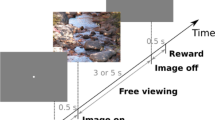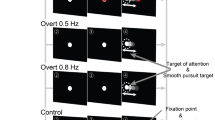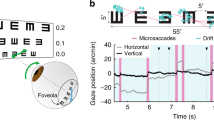Abstract
When we view the world around us, we constantly move our eyes. This brings objects of interest into the fovea and keeps them there, but visual sensitivity has been shown to deteriorate while the eyes are moving. Here we show that human sensitivity for some visual stimuli is improved during smooth pursuit eye movements. Detection thresholds for briefly flashed, colored stimuli were 16% lower during pursuit than during fixation. Similarly, detection thresholds for luminance-defined stimuli of high spatial frequency were lowered. These findings suggest that the pursuit-induced sensitivity increase may have its neuronal origin in the parvocellular retino-thalamic system. This implies that the visual system not only uses feedback connections to improve processing for locations and objects being attended to, but that a whole processing subsystem can be boosted. During pursuit, facilitation of the parvocellular system may reduce motion blur for stationary objects and increase sensitivity to speed changes of the tracked object.
This is a preview of subscription content, access via your institution
Access options
Subscribe to this journal
Receive 12 print issues and online access
$209.00 per year
only $17.42 per issue
Buy this article
- Purchase on Springer Link
- Instant access to full article PDF
Prices may be subject to local taxes which are calculated during checkout






Similar content being viewed by others
References
Martinez-Conde, S., Macknik, S.L. & Hubel, D.H. The role of fixational eye movements in visual perception. Nat. Rev. Neurosci. 5, 229–240 (2004).
Rucci, M., Iovin, R., Poletti, M. & Santini, F. Miniature eye movements enhance fine spatial detail. Nature 447, 851–854 (2007).
Burr, D.C., Morrone, M.C. & Ross, J. Selective suppression of the magnocellular visual pathway during saccadic eye movements. Nature 371, 511–513 (1994).
Ross, J., Morrone, M.C. & Burr, D.C. Compression of visual space before saccades. Nature 386, 598–601 (1997).
Morrone, M.C., Ross, J. & Burr, D. Saccadic eye movements cause compression of time as well as space. Nat. Neurosci. 8, 950–954 (2005).
Khurana, B. & Kowler, E. Shared attentional control of smooth eye movement and perception. Vision Res. 27, 1603–1618 (1987).
Kerzel, D. & Ziegler, N.E. Visual short-term memory during smooth pursuit eye movements. J. Exp. Psychol. Hum. Percept. Perform. 31, 354–372 (2005).
Turano, K.A. & Heidenreich, S.M. Eye movements affect the perceived speed of visual motion. Vision Res. 39, 1177–1187 (1999).
Kerzel, D., Aivar, M.P., Ziegler, N.E. & Brenner, E. Mislocalization of flashes during smooth pursuit hardly depends on the lighting conditions. Vision Res. 46, 1145–1154 (2006).
Schütz, A.C., Delipetkos, E., Braun, D.I., Kerzel, D. & Gegenfurtner, K.R. Temporal contrast sensitivity during smooth pursuit eye movements. J. Vis. 7, 3.1–3.15 (2007).
Derrington, A.M., Krauskopf, J. & Lennie, P. Chromatic mechanisms in lateral geniculate nucleus of macaque. J. Physiol. (Lond.) 357, 241–265 (1984).
Levitt, H. Transformed up-down methods in psychoacoustics. J. Acoust. Soc. Am. 49, 467–477 (1971).
Krauzlis, R.J. & Lisberger, S.G. Temporal properties of visual motion signals for the initiation of smooth pursuit eye movements in monkeys. J. Neurophysiol. 72, 150–162 (1994).
Lisberger, S.G., Morris, E.J. & Tychsen, L. Visual motion processing and sensory-motor integration for smooth pursuit eye movements. Annu. Rev. Neurosci. 10, 97–129 (1987).
Gegenfurtner, K.R. et al. Chromatic properties of neurons in macaque MT. Vis. Neurosci. 11, 455–466 (1994).
Gegenfurtner, K.R. & Hawken, M.J. Interaction of motion and color in the visual pathways. Trends Neurosci. 19, 394–401 (1996).
Chaparro, A., Stromeyer, C.F. III, Huang, E.P., Kronauer, R.E. & Eskew, R.T. Jr. Colour is what the eye sees best. Nature 361, 348–350 (1993).
Schiller, P.H., Logothetis, N.K. & Charles, E.R. Functions of the colour-opponent and broad-band channels of the visual system. Nature 343, 68–70 (1990).
Merigan, W.H., Katz, L.M. & Maunsell, J.H. The effects of parvocellular lateral geniculate lesions on the acuity and contrast sensitivity of macaque monkeys. J. Neurosci. 11, 994–1001 (1991).
Casagrande, V.A. A third parallel visual pathway to primate area V1. Trends Neurosci. 17, 305–310 (1994).
Nishida, S., Watanabe, J., Kuriki, I. & Tokimoto, T. Human visual system integrates color signals along a motion trajectory. Curr. Biol. 17, 366–372 (2007).
Schwartz, J.D. & Lisberger, S.G. Initial tracking conditions modulate the gain of visuo-motor transmission for smooth pursuit eye movements in monkeys. Vis. Neurosci. 11, 411–424 (1994).
Tanaka, M. & Lisberger, S.G. Regulation of the gain of visually guided smooth-pursuit eye movements by frontal cortex. Nature 409, 191–194 (2001).
Van Donkelaar, P. & Drew, A.S. The allocation of attention during smooth pursuit eye movements. Prog. Brain Res. 140, 267–277 (2002).
Ilg, U.J. & Thier, P. Inability of rhesus monkey area V1 to discriminate between self-induced and externally induced retinal image slip. Eur. J. Neurosci. 8, 1156–1166 (1996).
von Holst, E. & Mittelstaed, E. Das Reafferenzprinzip. Naturwissenschaften 37, 464–475 (1950).
Burr, D.C. & Morrone, M.C. Temporal impulse response functions for luminance and colour during saccades. Vision Res. 36, 2069–2078 (1996).
Ramachandran, V.S. Perception of shape from shading. Nature 331, 163–166 (1988).
Hansen, T., Olkkonen, M., Walter, S. & Gegenfurtner, K.R. Memory modulates color appearance. Nat. Neurosci. 9, 1367–1368 (2006).
Schmolesky, M.T. et al. Signal timing across the macaque visual system. J. Neurophysiol. 79, 3272–3278 (1998).
Ilg, U.J., Schumann, S. & Thier, P. Posterior parietal cortex neurons encode target motion in world-centered coordinates. Neuron 43, 145–151 (2004).
Ilg, U.J. & Thier, P. Visual tracking neurons in primate area MST are activated by smooth-pursuit eye movements of an “imaginary” target. J. Neurophysiol. 90, 1489–1502 (2003).
Ono, S. & Mustari, M.J. Extraretinal signals in MSTd neurons related to volitional smooth pursuit. J. Neurophysiol. 96, 2819–2825 (2006).
Freeman, T.C. Extra-retinal vision: firing at will. Curr. Biol. 17, R99–R101 (2007).
Tanaka, M. & Lisberger, S.G. Role of arcuate frontal cortex of monkeys in smooth pursuit eye movements. I. Basic response properties to retinal image motion and position. J. Neurophysiol. 87, 2684–2699 (2002).
Osborne, L.C., Hohl, S.S., Bialek, W. & Lisberger, S.G. Time course of precision in smooth-pursuit eye movements of monkeys. J. Neurosci. 27, 2987–2998 (2007).
Bedell, H.E. & Lott, L.A. Suppression of motion-produced smear during smooth pursuit eye movements. Curr. Biol. 6, 1032–1034 (1996).
Tong, J., Aydin, M. & Bedell, H.E. Direction and extent of perceived motion smear during pursuit eye movement. Vision Res. 47, 1011–1019 (2007).
Segraves, M.A. & Goldberg, M.E. Effect of stimulus position and velocity upon the maintenance of smooth pursuit eye velocity. Vision Res. 34, 2477–2482 (1994).
Blohm, G., Missal, M. & Lefevre, P. Direct evidence for a position input to the smooth pursuit system. J. Neurophysiol. 94, 712–721 (2005).
Perrone, J.A. & Thiele, A. Speed skills: measuring the visual speed analyzing properties of primate MT neurons. Nat. Neurosci. 4, 526–532 (2001).
Mikami, A., Newsome, W.T. & Wurtz, R.H. Motion selectivity in macaque visual cortex. I. Mechanisms of direction and speed selectivity in extrastriate area MT. J. Neurophysiol. 55, 1308–1327 (1986).
Newsome, W.T., Wurtz, R.H., Dursteler, M.R. & Mikami, A. Deficits in visual motion processing following ibotenic acid lesions of the middle temporal visual area of the macaque monkey. J. Neurosci. 5, 825–840 (1985).
Wilmer, J.B. & Nakayama, K. Two distinct visual motion mechanisms for smooth pursuit: evidence from individual differences. Neuron 54, 987–1000 (2007).
Seiffert, A.E. & Cavanagh, P. Position-based motion perception for color and texture stimuli: effects of contrast and speed. Vision Res. 39, 4172–4185 (1999).
Segraves, M.A. et al. The role of striate cortex in the guidance of eye movements in the monkey. J. Neurosci. 7, 3040–3058 (1987).
Krauzlis, R.J., Basso, M.A. & Wurtz, R.H. Shared motor error for multiple eye movements. Science 276, 1693–1695 (1997).
Schütz, A.C., Braun, D.I. & Gegenfurtner, K.R. Contrast sensitivity during the initiation of smooth pursuit eye movements. Vision Res. 47, 2767–2777 (2007).
Wyatt, H.J. Detecting saccades with jerk. Vision Res. 38, 2147–2153 (1998).
Wichmann, F.A. & Hill, N.J. The psychometric function: I. Fitting, sampling, and goodness of fit. Percept. Psychophys. 63, 1293–1313 (2001).
Acknowledgements
We thank M. Hawken and M. Spering for comments and suggestions, U. Kleinholderman and W. Kirchner for technical assistance and S. Bader, M. Höfer and E. Baumgartner for help with data collection. This work was supported by the German Research Foundation Forschergruppe “Perception and Action” and the German Research Foundation Graduiertenkolleg “NeuroAct”.
Author information
Authors and Affiliations
Corresponding author
Supplementary information
Supplementary Text and Figures
Supplementary Figures 1–4 and Supplementary Note (PDF 212 kb)
Rights and permissions
About this article
Cite this article
Schütz, A., Braun, D., Kerzel, D. et al. Improved visual sensitivity during smooth pursuit eye movements. Nat Neurosci 11, 1211–1216 (2008). https://doi.org/10.1038/nn.2194
Received:
Accepted:
Published:
Issue Date:
DOI: https://doi.org/10.1038/nn.2194
This article is cited by
-
Form Properties of Moving Targets Bias Smooth Pursuit Target Selection in Monkeys
Neuroscience Bulletin (2023)
-
Neural sensitization improves encoding fidelity in the primate retina
Nature Communications (2019)
-
Flash-lag effect: complicating motion extrapolation of the moving reference-stimulus paradoxically augments the effect
Psychological Research (2012)
-
Goal-Directed and Goal-Less Imitation in Autism Spectrum Disorder
Journal of Autism and Developmental Disorders (2012)
-
Precision and accuracy of ocular following: influence of age and type of eye movement
Experimental Brain Research (2010)



